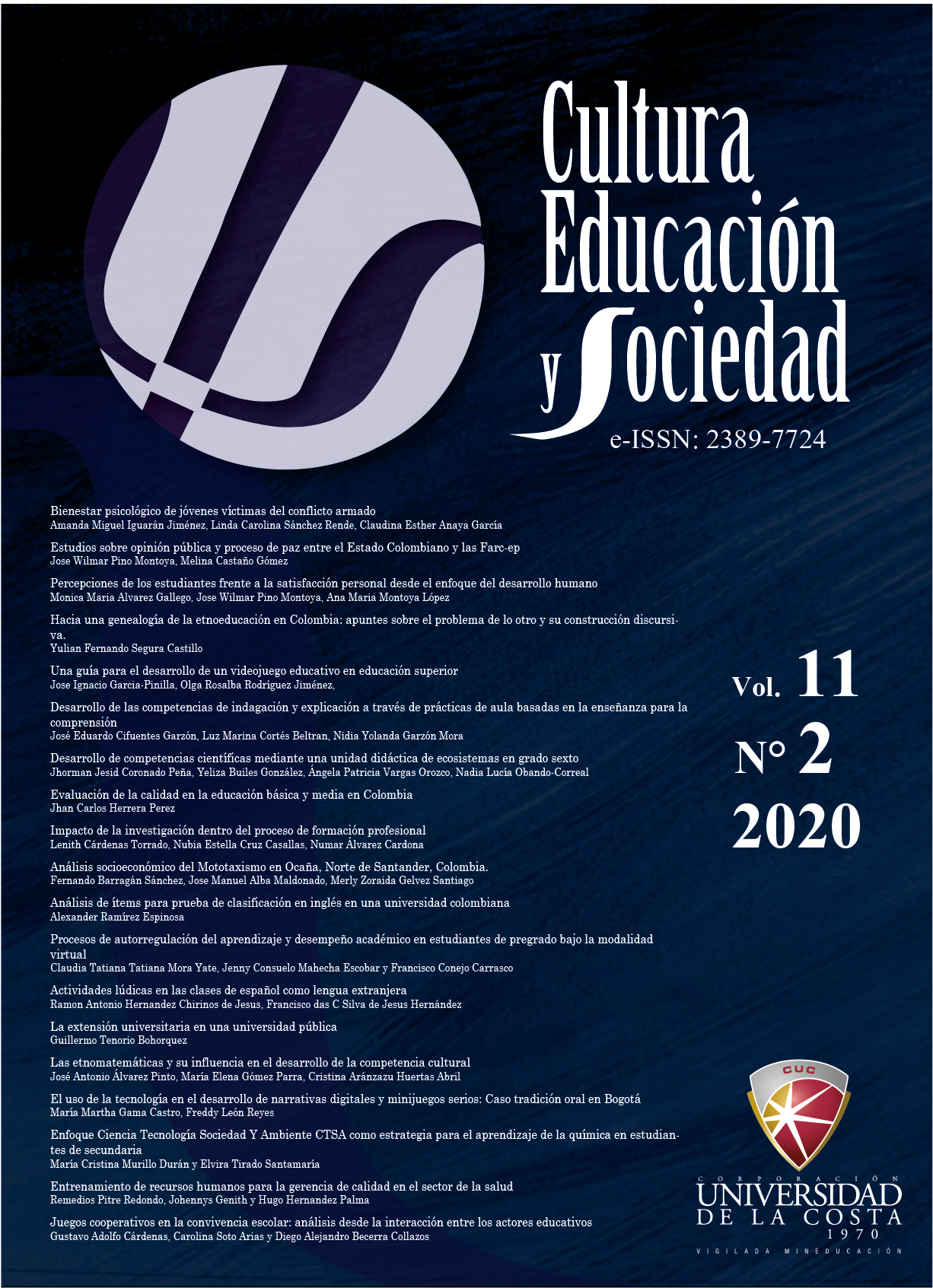Impact of ethnomathematics on the development of intercultural competence
DOI:
https://doi.org/10.17981/cultedusoc.11.2.2020.15Keywords:
Ethnomathematics, Intercultural competence, Verbal and non-verbal communicationAbstract
The school of the 21st century includes the intercultural approach with the aim of making the education of the individual integral. In this sense, many of the methodologies and classroom dynamics are not the most appropriate for addressing this objective fully. This study proposed the follow-up of five groups of primary school students with the objectives of measuring significant differences by gender, if any, and checking whether the practice of ethnomathematics as a teaching tool improves intercultural knowledge, skills and attitudes among the participating students, thus improving the intercultural competences of the students. For the development of the intervention we have used the translation of a rubric belonging to the Association of American Colleges and Universities by means of the Delphi method, (Rubric, 2010) with the aim of assessing the intercultural competence of the students before and after the implementation of ethnomathematics. After the educational intervention, it was observed that there were no significant differences in the gender of the participating students, but significant differences were found in the improvement of their intercultural competence. Our conclusions point out that the implementation of ethnomathematics has a positive effect in Primary Education classrooms for the improvement of students' intercultural competence which can be included by a number of methods and approaches (e.g. CLIL).
Downloads
References
Afanásiev, A. N. (1985). Cuentos populares rusos. Madrid: Anaya.
Aroca, A. (2016). La definición etimológica de Etnomatemática e implicaciones en Educación Matemática. Educación matemática, 28(2), 175–195. Disponible en http://www.revista-educacion-matematica.com/revista/2016/08/03/la-definicion-etimologica-de-etnomatematica-e-implicaciones-en-educacion-matematica-ensayo/
AAC&U. (2010). Association of American Colleges and Universities. [Online]. Available from https://www.aacu.org/value/rubrics
Blank, W. (1997). Authentic instruction. In: W. E. Blank & S. Harwell (Eds.), Promising practices for connecting high school to the real world (pp. 15–21). Tampa: University of South Florida.
Bok, D. (2006). Our Underachieving Colleges: A Candid Look at How Much Students Learn and Why They Should Be Learning More. Princeton: Princeton University Press.
D’Ambrosio, U. (1985). Ethnomathematics and its Place in the History and Pedagogy of Mathematics. For the Learning of Mathematics, 5(1), 44–48. Recuperado de https://flm-journal.org/Articles/72AAA4C74C1AA8F2ADBC208D7E391C.pdf
Deardorff, D. K. (2011). Assessing intercultural competence. New directions for institutional research, (149), 65–79. https://doi.org/10.1002/ir.381
Deardorff, D. K. (2006). Identification and assessment of intercultural competence as a student outcome of internationalization. Journal of Studies in International Education, 10, 241–266. https://doi.org/10.1177/1028315306287002
Dickinson, K. P., Soukamneuth, S., Yu, H. C., Kimball, M., D’Amico, R., Perry, R., Kingsley, Ch. & Curan, S. P. (1998). Providing educational services in the Summer Youth Employment and Training Program. [Technical assistance guide]. Washington, DC: U.S.
Don, L. (2017). El don de la tortuga. Barcelona: Vicens-Vives.
Don, L. y Williamson, M. (2016). El lobo hambriento. Barcelona: Vicens-Vives.
Finch, M. (2017). La princesa de los manantiales. Barcelona: Vicens-Vives.
Flanagan, L. (2017). La ingeniosa trampa de Dara (Un mundo de cuentos). Barcelona: Vicens-Vives.
Harwell, S. (1997). Project-based learning. In: W. E. Blank & S. Harwell (Eds.), Promising practices for connecting high school to the real world (pp. 23–28). Tampa: University of South Florida.
Hayes, M. (1991). Report of State Health Officer Washington. Washington: Washington State Health Officer
Hunting, R. (1986). El Aprendizaje, la Cosmovisión Aborigen y la Etnomatemática. Boletines del Grupo de Estudio Internacional de Etnomatemática, ISGEm 1985-2003, 2(1), 7–8. Recuperado de http://etnomatematica.univalle.edu.co
Junta de Andalucía. (10 de agosto de 2007). Por la que se desarrolla el currículo correspondiente a la Educación Primaria en Andalucía. [BOJA núm. 171]. Andalucía: Consejería de Educación. Recuperado de http://www.e-torredebabel.com/leyes/Primaria-Loe-Andalucia/matematicas-primaria-loe-andalucia.htm
Oviedo, H. C. & Campo-Arias, A. (2005). An approach to the use of Cronbach’s Alfa. Revista Colombiana de Psiquiatría, 34(4), 572–580. Disponible en http://psiquiatria.org.co/web/publicaciones/revista-colombiana-de-psiquiatria/volumen-34-n-4-ano-2005/metodologia/aproximacion-al-uso-del-coeficiente-alfa-de-cronbach/
Parnell, F. (2017). El abominable hombre de las nieves (Un Mundo de Cuentos). Barcelona: Vicens-Vives.
Pring, R. (1976). Curriculum organization. París: Paris University Press.
Rodríguez, M. (2013). La educación matemática en la conformación del ciudadano. Revista TELOS, 15(2), 215–230. Disponible en http://ojs.urbe.edu/index.php/telos/article/view/2158
Vithal, R. & Skovsmose, O. (1997). The end of innocence: a critique of “ethnomathematics”. Educational Studies in Mathematics, 34, 131–157. https://doi.org/10.1023/A:1002971922833
Published
How to Cite
Issue
Section
License
Copyright (c) 2022 CULTURA EDUCACIÓN Y SOCIEDAD

This work is licensed under a Creative Commons Attribution-NonCommercial-NoDerivatives 4.0 International License.
![]()
Creative Commons 2020 CULTURA EDUCACIÓN Y SOCIEDAD
This article is under international license Creative Commons Reconocimiento-NoComercial-SinObrasDerivadas 4.0.
The published articles are the sole responsibility of their authors and do not necessarily reflect the opinions of the editorial committee.
CULTURA EDUCACIÓN Y SOCIEDAD respects the moral rights of its authors, who assign to the editorial committee the patrimonial rights of the published material. In turn, the authors inform that this work is unpublished and has not been previously published.
All articles are under a:
Licencia Creative Commons Atribución-NoComercial-SinDerivadas 4.0 Internacional.
![]()


 English
English
 Español (España)
Español (España)




_12.53_.27_p_. m_._3.png)





_12.57_.35_p_. m_._3.png)
_12.50_.37_p_. m_._3.png)



